AMD Socket-AM2: Same Performance, Faster Memory, Lower Power
by Anand Lal Shimpi on May 23, 2006 12:14 PM EST- Posted in
- CPUs
Athlon 64 X2 5000+: A Cheap FX or Overpriced 4800+?
Although the FX-62 conclusion was pretty straight forward, the Athlon 64 X2 5000+ gives us another ambiguous candidate to evaluate. Clocked at 2.6GHz, the 5000+ gives you a nice clock speed advantage over previous X2s. However, with only a 512KB L2 cache there may be situations where the clock speed advantage over the Athlon 64 X2 4800+ is diminished.
3D Rendering - Cinebench 9.5
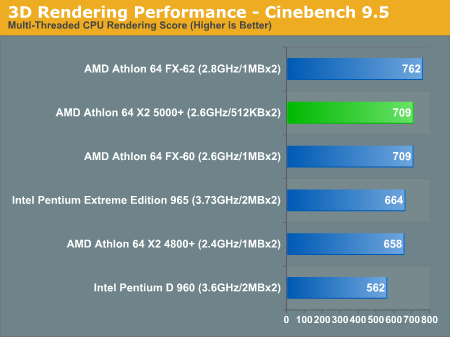
We've already seen that many of our 3D rendering and media encoding tests are cache-size independent when running on Athlon 64 X2/FX processors, thus it's no surprise that the X2 5000+ is able to offer identical performance to the FX-60 despite having half the L2 cache per core. The clock speed advantage over the X2 4800+ is also significant enough to offer a pretty decent performance advantage; in fact, in this light, the Athlon 64 X2 5000+ looks pretty impressive.
3D Rendering - 3dsmax 7
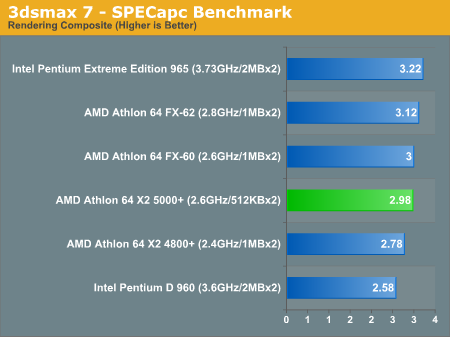
The story under 3dsmax 7 is pretty similar to what we saw under Cinebench; there is a slight performance penalty compared to the FX-60 thanks to a smaller L2 cache, but overall the performance of the X2 5000+ is quite respectable. As we saw in our FX-62 investigation from the previous page, the Extreme Edition 965 is very tough to beat in this test thanks to its high clock speed, very fast FSB and dual core + Hyper Threading combination.
Video Encoding - DivX 6.1.1 Pro
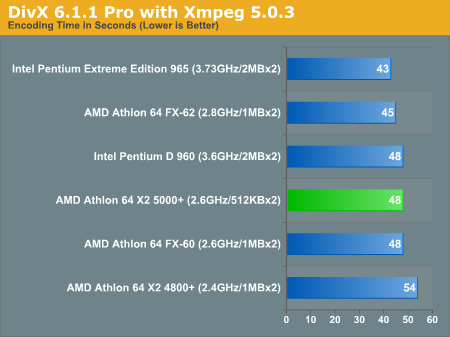
Once again, there's no performance difference between the X2 5000+ and the FX-60, bringing the 5000+ very close in performance to the FX-62 at a significantly lower cost. Thanks to the clock speed advantage, the 5000+ is also clearly faster than the X2 4800+.
Video Encoding - Windows Media Encoder 9
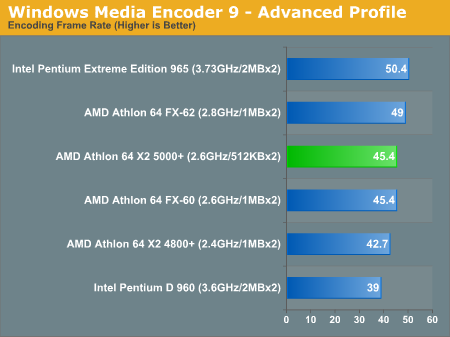
Windows Media Encoder 9 also has the X2 5000+ and FX-60 performing identically, and obviously outperforming the X2 4800+.
Video Encoding - Quicktime 7.0.4 (H.264)
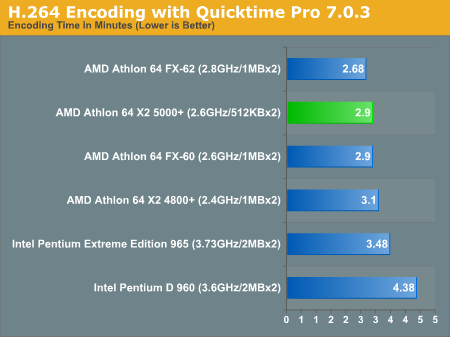
The video encoding trend continues with our Quicktime H.264 test, the 5000+ is second only to the FX-62.
MP3 Encoding - iTunes 6.0.1.4
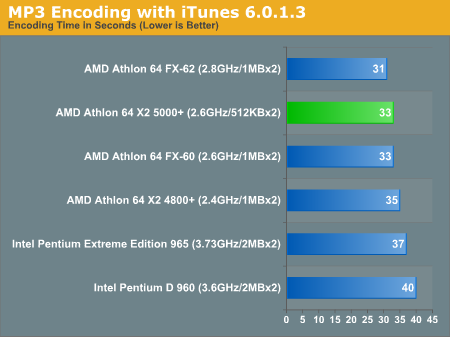
Our iTunes MP3 encoding test produces identical results to what we've already seen in previous benchmarks, the Athlon 64 X2 5000+ isn't really hampered by its 512KB L2 cache thus far.
Gaming - Quake 4
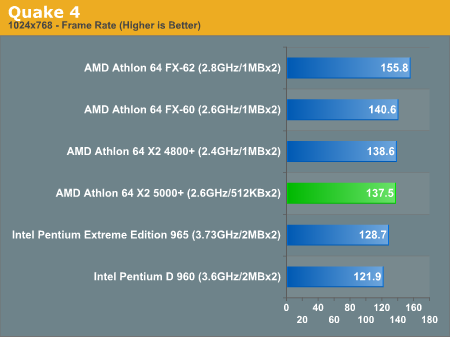
The tables do turn as we look at gaming performance however; not only does the Athlon 64 X2 5000+ lose to the FX-60, but it also loses to the lower clocked Athlon 64 X2 4800+. While the Athlon 64 X2 5000+ is wonderful in our application tests, it looks like there may be a very different verdict for gamers.
Gaming - F.E.A.R.

Under F.E.A.R. the FX-60 is faster than the X2 5000+ once again, but this time the best the X2 4800+ can manage is to tie the performance of the 5000+. Given the $51 price premium for the 5000+, we'd want something that was at least faster than the 4800+.
Gaming - Oblivion
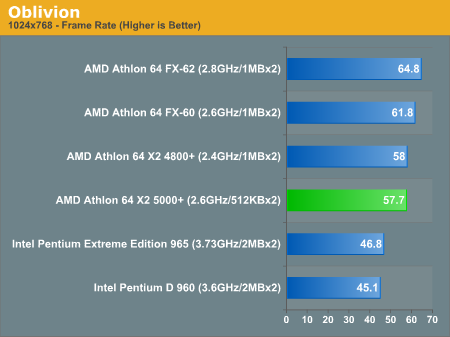
Finally in Oblivion we see that the X2 4800+ is ever so slightly faster than the 5000+, once again thanks to its larger L2 cache (despite a lower core clock speed).
The Athlon 64 X2 5000+ Conclusion
Once again we see the problem with AMD's model number system, where in some cases the 5000+ is no different than a FX-60 and in others it is only as fast if not slower than the cheaper X2 4800+. Our recommendation here would be to only opt for the 5000+ if you aren't a gamer, as it seems that 3D games are far more likely to appreciate a larger L2 cache than a higher clock speed with these chips.










83 Comments
View All Comments
peternelson - Tuesday, May 23, 2006 - link
I see no benchmarking in 64 bit mode.
This is the future, and for maths, Intel's 64 bit was more of a lame copy of AMD 64 bit performance.
In future this will be increasingly important so even if 32 bit performances are comparable, I'd want to make sure the picture is the same running 64 bit apps.
Also you summarise "same performance, faster memory, less power". True, but you FORGET one of the main benefits: Pacifica Virtualisation.
True hardware virtualisation adds to the actual WORK you can keep that processor busy with. It saves time by letting you switch OS instances without rebooting timewasting.
As it is hardware based VT you should even be able to virtualise an UNMODIFIED OS like Win XP, maybe even Vista!
So please play with Xen3.
As you say virtualisation "works" then it is a BIG factor for me in choosing AM2 over 939, (all other things being equal).
Also the fastest 939 chips have been produced, and AM2 is reaching higher models now.
So if you want the VERY fastest, it is only available on AM2.
Don't forget: Not just performance, but performance PER WATT. For these AM2 chips that is similar to 939.
However, the announcement of 65W EE and EVEN 35W SFF EE!!! are significant compared to the standard 89W
Intel seem to be positioning Conroe as being "33% better" on performance per watt. However, Conroe isn't even here but when it is, it may not be able to compete with AMD low power offerings.
Also consider the whole system for conroe vs AMD. Because that AMD power INCLUDES the memory controller, whereas Intel doesn't. The whole motherboard etc may use less power.
Also in terms of entire system cost, motherboards for AM2 appear to be a bit cheaper than their Intel equivalents, which may offset the current high prices of AMD processors.
fitten - Wednesday, May 24, 2006 - link
You should check out the Woodcrest (server targeted Conroe core) previews for power measurements. Performance per Watt, Woodcrest wins (and will be available in 3 weeks)... Absolute power usage under load, Woodcrest wins... and note that the power measurements are for the complete system (video card and HDDs included). (Deep power conservation couldn't be tested on Woodcrest because the parts didn't have it enabled as they were engineering samples.)Also, check out the 64bit vs. 32bit comparisons in programs like Cinebench 9.5. Seems Woodcrest 64bit gives a nice boost there (showing that it isn't just a 'lame copy').
You also seem to forget that Intel already has virtualization extensions out in currently shipping processors (much less Conroe+).
As far as price, there have been price lists published already. High end Conroe parts are already listed for 1/2 the price of the high end AMD parts... at $500 that gives another $500 for purchase of a motherboard before it touches just the CPU cost of the AMD... I doubt that the motherboards will be that expensive.
I have 7 AMD machines (four are Athlon64s or X2s) but right now, it looks like my next machine will be a Core2 one. AMD needs to get an answer out... soon. K8L isn't going to cut it. Sure, it'll be good at FPU but the vast majority of work done by CPUs is integer, which are what the majority of improvements are in Core2 (not that they don't have good FPU improvements). So, if you're in a government lab running FPU intensive simulations, K8L may be for you. If you're anyone else, K8L as it has been described looks kind of anemic and not a match for Core2.
Maybe the real K8L will surprise us, who knows, but it is at least 6 months away (if not longer). By that time, Intel will already be 25% into it's 2-year cycle for the next Core derivative chip (probably farther, time between releases is set to 2-years). AMD looks to be in a bad situation right now... If they have something they're keeping secret, IMO, they need to at least tease us with it. K8L is not a tease, it's only slightly more than a stifled yawn. The longer they go without giving us something to look forward to, the more it looks like they are in major trouble.
Accord99 - Wednesday, May 24, 2006 - link
[quote]Don't forget: Not just performance, but performance PER WATT. For these AM2 chips that is similar to 939.However, the announcement of 65W EE and EVEN 35W SFF EE!!! are significant compared to the standard 89W
Intel seem to be positioning Conroe as being "33% better" on performance per watt. However, Conroe isn't even here but when it is, it may not be able to compete with AMD low power offerings. [/quote]
Given that Woodcrest 3.0GHz has a TDP of 65W, which is borne out by power measurements conducted by Techreport and 2CPU, it's likely that a Conroe that matches the performance of the 35W X2 will at the very least, also match it in power.
soydios - Tuesday, May 23, 2006 - link
AMD motherboards are less expensive because they don't have to put in a memory controller.AMD processors are more expensive for 2 reasons:
- integrated memory controller takes up more die space (offset by cheaper motherboard)
- AMD is still using 90nm on 200mm wafers, while Intel is using 65nm on 300mm wafers (Intel gets more CPUs per wafer bigtime)
peternelson - Tuesday, May 23, 2006 - link
Sempron AM2 can do memory up to DDR2-667
Dualcore AM2 can do memory up to DDR2-800
However, PLEASE CHECK SINGLE CORE MEMORY SPEED (multiplier issues aside) which you say limited to 667 whereas I got the impression they can also do 800 like dualcores. Correct as necessary.
smitty3268 - Tuesday, May 23, 2006 - link
I accidentally hit the "not worth reading" button, so I'm writing this comment to undo it :)fikimiki - Tuesday, May 23, 2006 - link
There are a couple of reasons for that:- K8L photo had a Z-RAM implemented, so they are using this kind of cache for a quite long time.
- Shared L3 should help Athlon64 in matching Super-Pi and overall performance.
- Usage of Z-RAM will reduce cache die size by 75% with no architectural changes.
So FX-64 to beat fastest Core 2 just needs 4MB of cache...
Easy trick but can be useful to survive till 65nm production...
Questar - Tuesday, May 23, 2006 - link
It's not going to be Z-RAM. Z-RAM won't even be in K8L.
“We’ve looked at data from Innovative Silicon and it looks very promising. We still need to assure ourselves that this will work in our own application. We need to see how it scales and we need to make our own test vehicles,”
Jones, an executive experienced in intellectual property licensing, also declined to comment on AMD’s timetable for introduction of Z-RAM but offered a more general perspective. “In the past it has been two years from when you sign a deal to when it is in production.”
http://www.eetimes.com/news/latest/showArticle.jht...">http://www.eetimes.com/news/latest/showArticle.jht...
munky - Tuesday, May 23, 2006 - link
I think the June trick AMD will pull out is the Clearspeed coprocessor. It definitely won't affect many users, but for those who do invest in the technology, it could provide a decent boost in number crunching power.peternelson - Tuesday, May 23, 2006 - link
Clearspeed are working on being one acceleration solution, yes, but the already launched acceleration on socket 940 is companies offering plug in Xilinx4 FPGA on hypertransport.
I hope that gets re-engineered onto socket F pretty quickly. We may see announcements once socket F is actually launched in July.